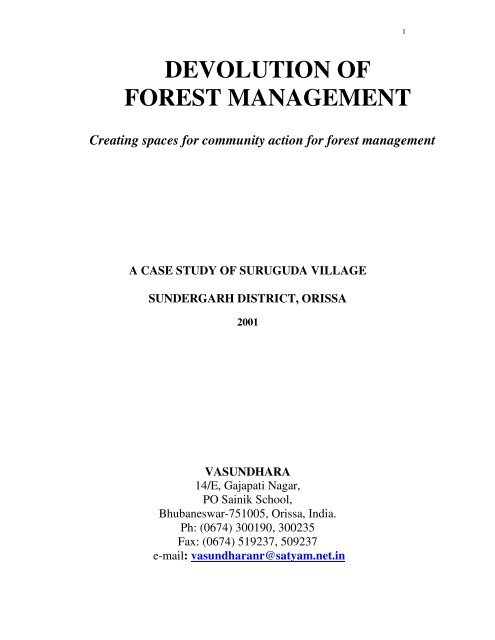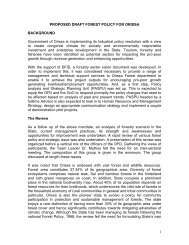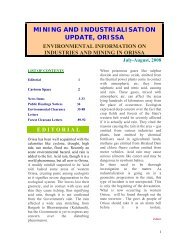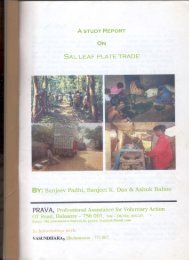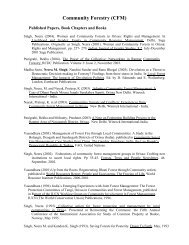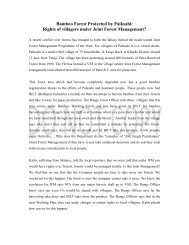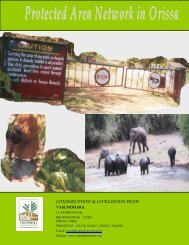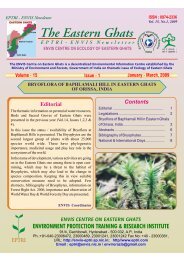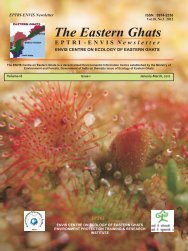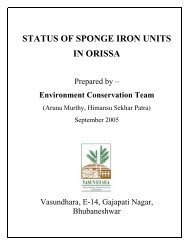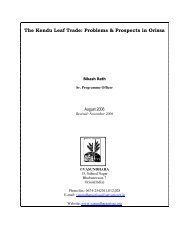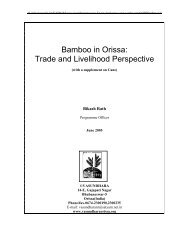DEVOLUTION OF FOREST MANAGEMENT - Vasundhara
DEVOLUTION OF FOREST MANAGEMENT - Vasundhara
DEVOLUTION OF FOREST MANAGEMENT - Vasundhara
- No tags were found...
Create successful ePaper yourself
Turn your PDF publications into a flip-book with our unique Google optimized e-Paper software.
1<strong>DEVOLUTION</strong> <strong>OF</strong><strong>FOREST</strong> <strong>MANAGEMENT</strong>Creating spaces for community action for forest managementA CASE STUDY <strong>OF</strong> SURUGUDA VILLAGESUNDERGARH DISTRICT, ORISSA2001VASUNDHARA14/E, Gajapati Nagar,PO Sainik School,Bhubaneswar-751005, Orissa, India.Ph: (0674) 300190, 300235Fax: (0674) 519237, 509237e-mail: vasundharanr@satyam.net.in
2Suruguda Village(CFM converted to JFM)Community initiated Forest Protection formalised as JFM arrangement1.0 INTRODUCTIONSuruguda is a large heterogeneous village in Sundergarh district of Orissa underScheduled Areas 1 . The village started forest protection, way back in 1985. Since thenit has received several awards and also considerable attention of the ForestDepartment (FD). This village was selected for our study to focus on:i) Equity issue in the context of a heterogeneous village in the Scheduled Areas.For this purpose we have attempted to explore the inter as well intracommunity interactions in the context of forest resource management. Againas the FD has shown considerable enthusiasm 2 , we felt it is pertinent tounderstand their role vis-à-vis the question of equity.ii) Role of the FD and impact of FD support on the CFM. Suruguda is one of thefirst villages in the district , possibly in the state where the FD promoted JointForest Management (JFM). We have attempted to document the transitionfrom community initiated forest management system to JFM system so as tounderstand the impact and implication of FD intervention.As noted earlier, in Suruguda forest protection began in 1985. The FD startedsupporting the village in 1988 and formed the Forest Protection Committee as per the1988 resolution. Ultimately in 1994, Vana Samrakhan Samiti (VSS) was formed inthe village as per JFM resolution of 1993.It is of important to note here that the forest protection initiative in the village camefrom Harijan hamlet to restrict the access of neighbouring villagers (JhariapaliVillage) to the forest. The Jhariapali villagers denied the Harijans of Suruguda to takerice from a ration shop of their village. As retaliation the Harijans started protectingthe forest and denied the Jhariapali villagers. Gradually the forest protection effortevolved into a full-fledged CFM system and the entire village got involved. Ironically,the Harijans who initiated the process are increasingly marginalised from the CFMsystem and Agharia have been consolidating their position.1 Scheduled Areas refers to areas declared as Scheduled areas on the basis of the intensity of tribalpopulation as per the clause (1) of article 244 of the Constitution.2 There was a govt. order to the FD to start a drive for V..S.S. formation. To comply with govt. orderFD personnel of respective division had taken interest to form V..S.S. Secondly a young and dynamicRange Officer transferred to the Ujjalpur range often pays visit to the protecting groups.
32.0 Background of Suruguda Village2.1 LocationSuruguda is located 23 Kmsaway from the Districtheadquarters i.e. Sundargarhand just 8 Kms away from theBlock headquarter. The riverIccha passes through thevillage leaving Four of herhamlets on the other bank.This segregation hassignificant impact on the lifeof people. The four hamletsthough are part of the revenuevillage maintain a differentidentity have their ownmanagement system and havelittle alliance with the main.They are not involved inforest protection. So, we haveexcluded them from the scopeof the study. As far as thestudy is concerned Surugudarefers to 6 hamlets consistingof 155 no of HH at the time ofstudy.2.2 History of the VillageThe history of Suruguda isabout 300years old 3 . In thepast it was popular as ahunting ground. Kingsfrequented this place forhunting wild animalsespecially tiger, which were inabundance because of denseforest cover. The name‘Suruguda’ is said to havecome from the words ‘Suru’and ‘Guda’. The term ‘Suru’ June 25, 1998or ‘begin’ is said to refer tobeginning of hunting campsby the Britishers in this areaand ‘Guda’ refers to theabundant uncultivable lands scattered in the area.Village Timeline 1> 300 years Settlement of Suruguda villageAround 1856 Agharias came in1918-20 First Middle Vernacular passed(Ramcharan Patel 1 )Private pond constructed by RamcharanPatel in the village1949-50 100 HHs in the village (32 patta holdersand 68 landless)1949 Viswa Shanti Yagyna organised by ShriRamcharan Patel1949 Vegetables exhibition organised1950 Shri Ramcharan Patel became the firstnominated MLA of the constituency1951-52 First car brought to the village by RamCharan Patel1952-53 First Matriculate (Pankaj Patel)1954 – 55 Raghunath Patel became the first StateGovernment Service holder as SchoolMaster1957 Primary school established1958 First intermediate and also the firstgraduate of the village in 1961 (ShivShankar Patel)Around 1960 Metallic road from Sundargarh to Hemgiripassing through the village wasconstructed and a mini-bus started plying.1970 Control (Government Retailer) shopopened by a villager1973-74 The village connected to the Electricitygrid.1977-78 Upgraded Middle Education School startedin the village1977-78 Tube-wells set up in the village.1981-82 Rath Yatra (famous car festival of LordJagannath) organised & celebrated in thevillage for the first time1985 First haat (local market) estd. in thevillage. But due to degraded foresrtcondition no NTFP found in market1987 – 88 High School started in the villageIntroduction of hybrid variety of paddy1991 Anganwadi centre opened in the villageMost severe flooding in the area recordedtill date.3 . In the absence of written history, the history of the village has been drawn from oral sources.
4Bhuiyans are believed to be the primitive settlers of the area and Mr. Menjir Naik wasthe Gauntia 4 of this area. Suruguda people are said to have migrated from Loisingha(Balangir), Sundargarh, Ujjalpur (Sundergarh) areas.It is difficult to say when and how exactly the Agharia community migrated to thisplace. However, locals say that they migrated around 1856/57. In the said year, GopalPatel and Govind Patel purchased the Suruguda village from the king and became itsGauntia.During the pre independence period the village was directly under king’sadministration. At the village level, the Gauntia with help of ‘Panch Bhlaloks’(Council of elders) was responsible to mange the internal comprised of elders fromAgharia, Bhuiyan and Teli caste.2.3 Demographic DetailsSuruguda is a heterogeneousvillage with the presence ofthe following castes: Agharia,Brahmin, Bhuiyans, Harijan,Chamar, Gond, Teli,Dhanwar, Gauda, Kissan,Keuta, Lohar, and Majhi.Agharia is the dominant castegroupin the village.Detailed caste composition ofhh involved in forestprotection is given in Table 1.2.4 OccupationAgriculture, Service,Agricultural labour,construction labour,Blacksmith, Milkman,Carpentry and Bambooweaving are the few majoroccupation in the village. Thecarpenters get wood from theunprotected forest areas,which is about 15 to 20 Kmaway from the village. TheBamboo weaving is anoccasional occupation, onlyTable 1Households involved in forest protection:Hamlets Total Caste Groups hh 1(Pada) hhsdistn.Agharia Pada 19 Agharia 19Bhuinya Pada 38 BhuinyaAghariaDhobaTeliBarikaKeuta16103522Gauda Pada 24 GaudaDhanuarLoharHarijan Pada 22Brahman Pada 25ChamarHarijanAghariaGhasiBhuinyanTeliBrahmanAghariaKisanGondwhen they get any order they get engaged in the activity. A few households areinvolved in leaf plate and cup making as a supplementary economic activity.1563313153135103Bandha Pada 7 AghariaBhuinyan52Milu Pada 20 Kisan 20TOTAL HHS 1554 Gauntia (Village headman) is an intermediary at the village level between the king and the people.His responsibility was to collect revenue on behalf of the king. In lieu this service lie was allowed toenjoy certain benefits like rent-free land, free labour etc.
52.5 Forest Resource of the villageForests adjoining to the village are Bindha Reserve forest (R.F. ) and Bhalutungri Khesra forest.At present, Suruguda village is protecting 80 hectares of the Reserve Forest and 40 hectares ofKhesra forest (revenue forest). Bindha R.F. was declared as Reserved Forest in the year, (videnotification no: 1166FD/12F-M/2-152/62-CF, <strong>OF</strong>A, 1972).The forests is mixed Sal forests, the main forest species are Sal and its associates such as Asan,0Dheuru, Bheru, Sidha, Karda, Char, Kendu, Dhuben, Salhaya, Kekat, Banem, Khair, Gamharetc. The R.F. is on the hills and the lower part of the R.F. has a gentle slope and a dominant cropof Sal coppice. The vegetation in the upper reaches is dominated by bamboo.2.6 Village Management, Institution & Decision MakingWith the cessation of Gauntia system the control of Gauntia got weakened in the postindependentperiod. And instead many community institutions emerged. However,this does not mean that the role of Agharia community has diminished rather in newsituation in all most all community institution they play an important role.In Suruguda village, number of committees have been formed to manage differentmatters like the school committee Puja(festival) Committee etc. However decisionsrelating to village matters are taken in the village committee meeting in a collectivemanner.This forum is also used to solve disputes within the village. Normally disputesrelating to inter-personal conflict, functioning of other committee are referred to thevillage meeting. The affected person intimate the ward member about the dispute,who in turn calls the village meeting by circulating notice through Katuala 5 . Onlymale are allowed in this meeting and the women are not allowed. The decision takenin such meeting is normally adhered to. In case the matter is not resolved within thevillage or there is violation it is refered to civil administration.3.0 <strong>FOREST</strong> <strong>MANAGEMENT</strong>3.1 <strong>FOREST</strong>S AROUND SURUGUDA: THE CHANGING SCENARIOThe forest was in full vigour around 1950-55 when subsequent coupe felling by the governmentaccelerated the process of forest degradation. The last leasing operation (leasing of coupes tocontractors for timber felling) was carried out around 1970-75. During it’s better days, the foresthad a good concentration of trees like Sal, Bija, Karla, Bamboo, Khair, Gamhar, Kendu,Domkurlu, Kurlu, Vherua, Dhaula, Dhuben, Salheya, kekat, Banem, Sishu, etc.The forest got degenerated further between 1975-85. As one sees the following are themajor behind degeneration of forest in the year 1975-85.a) forest was leased out by the government to the contractors.b) Extravagant use of wood by villagers, especially by the Agharia community. It could beobserved that every Agharia house has consumed a lot of wood. At places one shall find thata whole tree has been used.5 Katual is a person who has the responsibility to inform the household about the schedule of themeeting
6c) Excessive grazing (As far as grazing is concerned HH from all communities having domesticanimals were involved)d) uncontrolled forest fires ande) Stone quarrying operations.Since 1985, after the initiation of forest protection the forest have started regenerating.At present the forest stand is quite dense but the concentration of trees like sisu, Khairand Sal has reduced. The regeneration has brought about some congestion, the treesare of average side. Bamboo, which are totally depleted has now came back and isyielding harvest.3.2 <strong>FOREST</strong> PROTECTION AND <strong>MANAGEMENT</strong> SYSTEM:3.2.1 InitiationThe protection campaign began in the year 1985 initiated by the members of the Harijancommunity and gradually the entire village (including Bhugrapada) participated. Though theBhugrapada broke away after some time, another hamlet i.e. Milu Pada belonging to a differentrevenue village, was included in the forest protection group.3.2.2 Trigger factor:The protection effort initially started as a retaliatory step by the Harijan community of Suruguda.Harijans from Suruguda were denied rice at the ration shop at Jhariapalli bazar. After this, in ameeting attended by members from Gauda pada, Brahmin pada and Dhanwar pada of Suruguda,it was decided not to allow the people of Jhariapalli to take produce from the nearby forest. It isimportant to note here that the people of Jhariapalli village depended on this forest patch forfirewood and for fencing material for their vegetable fields.In the initial stage leadership came from harijans from the harijan pada. The protection teamapproached Dukalu Pruseth (Ward Member) of Bhuiyan pada for guidance and appointed him asthe president of the Forest Protection Committee. Gangadhar Patel, the then Sarpanch was alsoinvited into the group and his help was also solicited. An application was sent to the DFOseeking his approval to protect the Reserve Forest patch. Soon after, the DFO gave his consentverbally and interest in the protection process was increased.A few months later, the entire village decided to join in. A village meeting was called to discusson collective protection. One member from each household (only male) was present in themeeting. At this meeting a seven-member committee was formed under the presidentship ofDukalu Pruseth and Secretary Purna Panda. Representation from all the hamlets was ensured inthe committee. Since the Harijans and Bhuiyans were pioneers in the protection process hencetwo members were invited from each of these communities.Though the incident with Jhariapalli was the immediate trigger for forest protection, there wereother long-standing concerns that influenced the decision to protect forests as well, these were:• Acute scarcity of fuelwood.• Lack of availability of wood for other purposes like house construction, agriculturalimplements etc.In the initial periods of protection people faced a lot of problem, as there was no ready alternatesource of firewood. During that period the villagers were mostly dependent on leaves andBhusee chullah (a locally developed stove wherein paddy husk is used as a fuel). For a few years
7they depended on the Amari branches from the riverbeds for cooking fuel. A few familiesdeveloped "Gobar gas" system under D.R.D.A. project but could not sustain because they did nothave requirement number of cattle.The Forest Department supported the forest protection effort by villagers by forming a VillageForest Protection Committee in the village as per the Government resolution of 1988in thisregard. After the JFM resolution of 1993, the Forest Department formed a Vana SamrakhanSamiti (VSS) in 1994 and entered into a Joint Forest Management arrangement with the village.3.2.2 Dynamic evolution of Forest Management GroupInitial initiative for forest protection came from the Harijan pada. After a few months, howeverthe entire village got involved. Within a brief period of three months after protection startedthere was an intrusion by two Agharia people who were caught red handed while cutting polesfrom the protected patch. The offenders were penalised. After this incident the entire villagedecided to join the protection effort.It is interesting to note that after this incident the Agarhias realised that they were being excludedfrom a potentially significant activity, and that their decision to join in was influenced by theneed to "regain" control over an important resource.3.2.3 Involvement of Bhugrapada in Forest Management Group:Bhugrapada, which consist of four hamlets, forms a major portion of Suruguda in terms ofhousehold and population. But it does not have any major link with the rest of the village otherthan the legal status. In the initial stage, the entire revenue village including Bhugrapada cametogether but after short period of time Bhugrapada broke away. Following factors may beattributed to this:• Bhugrapada is far off from the protected patch, which hindered the mobility of people, andhence they got disinterested.• Most of the households (nearly 163 out of 225) are landless and depends on daily wagelabour. Foregoing a day's work for patrolling spells a loss of earning for the day, which iscritical loss.• The Bhugrapada people could easily meet their needs from nearby forest patches to whichthey have unrestricted access.• Most of the household belong to the so-called lower caste and have little influence or say inthe village affairs. This has also proved to be a major obstacle in getting along with the restof the village.3.2.4 Inclusion of Milupada:Milupada does not come under the legal jurisdiction of Suruguda rather it is a hamlet of theadjoining Kolebira village. The significant thing about Milupada is its location (Refer to theresource map) which is highly strategic by virtue of its close proximity to the forest. It is a tribalhamlet and their degree of dependence on forest is much more. Their association is based on thefollowing reasons:• It was realised that inclusion of Milupada would enhance the effectiveness of themanagement system. Milupada's inclusion has actually enhanced the effectiveness of forestprotection.• Milupada decided to join in since that gave Milupada access to common resources ofSuruguda particularly the grazing land, since the grazing land is within the boundary ofSuruguda. Thus the whole affair was a matter of reciprocity.
83.2.5 Structure of Forest Protection and Management CommitteeThe first committee comprised of 7 executive body members and 120 general body members.Presently the number of members of Executive Committee has increased to 17. For a fairrepresentation the executive body, members from all the hamlets are included though theirnumber varies for different reasons. People of the respective hamlets select their representativesfor the executive body. The important office bearers in the committee are the President andSecretary.The General body through selection process appoints executive body members. For the first timeduring VSS formation in 1994 voting was done for the post of President and Secretary. The firstcommittee led by Shri Dukalu Prushet continued for quite a long period -for almost 11 yearsexcluding a few who resigned after two years on personal grounds. After the breakdown of thiscommittee frequent changes in the subsequent committees were observed. A major reason ofthese changes is absence of strong leadership and vested interest of some individuals within thevillage.Representation of Members from different hamlets in the FPCHamlet Members Sex Caste DesignationBhuinya Pada Alekh BhoiKhadi KaloPabitra PatelMaleMaleMaleSTBhuiyanAghariaMemberMemberPresidentSadashiv Patel Sarojini Patel MaleAgharia Vice- PresidentCharulata Patel(Sarpanch)FemaleFemaleAghariaAghariaMemberMemberBrahman Pada Laxman Kisan Male ST MemberHarijan Pada Gojendra BadiGulapi SaSesadev SunianiSukru Buda(Ward Member)MaleFemaleMaleMaleHarijanHarijanHarijanHarijanMemberMemberMemberMemberAgharia PadaMiluPadaBipin BudaTikina ChowdhuryMotiram Chowdhury(Ward Member)Somendra PatelKumar MajhiSaraswati KisanMaleMaleMaleMaleMaleFemaleHarijanAghariaAghariaAghariaSTSTMemberMemberMemberSecretaryMemberMember3.2.6 Frequency of MeetingsThe period of meetings is not strictly fixed. In the initial period meetings of theExecutive body took place once in a week. Gradually the frequency of meetingsdecreased to once in a month. Whenever required and or whenever an offender iscaught meetings are called immediately. The meetings focussed on protection systemand offences. The committee appoints a person from the village itself for intimatingnotice / information to the committee members and the villagers. The person whogives the message is called Katuala.Meetings of the FPC are generally held during night in the meeting hall of thecommittee. Depending upon the situation and urgency meeting is even held during thedaytime. While the executive body meeting is restricted only to the members, in thegeneral body meeting any individual from the village irrespective of membership canparticipate. But it is compulsory that at least one person from every household should
9attend the general body meeting. Usually male individuals attend the meetings. Evenafter the appointment of women members in the E.C and one female from everyhousehold representing in the general body, they hardly come to the meetings. Duringvery few occasions only when there is a meeting called by the FD or if there are anyvisitors from outside their presence is seen in the meeting. This kind of involvementcan at best be viewed as superficial participation.3.2.7 Rules relating to Forest Protection/ PatrollingProtection started with ‘complete restriction on entering the forest’. No individual wasallowed to go to the forest. Initially, six persons used to go for patrolling each day.Later on the number of pallias (volunteers for patrolling) were reduced to four. Now,two persons go for patrolling duty each day. Patrolling duties are on rotation basis andon a household basis (i.e. one person from the household whose turn comes).The system of patrolling is termed as "thengapalli", thenga refers to the wooden stick/baton that passes from household to household signifying the "turn" of that household.The patrolling responsibility thus shifts from household to household on a rotationalbasis. Night patrolling was also done initially for a period of two years. Graduallywhen the external threat reduced this was stopped. For the initial period of threemonths there was no forest protection committee. The president used to coordinate theentire process. In case any problem arose it was solved with mutual understanding.Recently when the study was carried out voluntary patrolling discontinued.3.2.8 Rules related to cleaning and thinning operationsThe General Body takes decision for annual cleaning and thinning operations. Acommon meeting of the village is convened where in at least one person from everyhousehold is present. The decisions are communicated to the Forester and the localRanger through the committee members. Under the joint supervision of the Forester,F.G. and the Committee cleaning is undertaken. In practice they do not remain presentfor the entire day of cleaning. President remains present in the spot during thecleaning period. However this does not apply to all members.During the silviculture operations only the invaluable species, dry and fallen branches,deceased tree branches and matured bamboo poles are harvested. No one is allowed tocut green trees. This was decided to allow the valuable species to grow. Differentpatches are being cleaned on rotational basis.Timeline of the functional dimension of Forest Protection and Managementsystem1955-60 Forest given in coupe to private contractors1970-71 Stones for construction of dam in the nearby was collected from thishillock1979-80 Plantation in Anabadi land adjacent to Bindha RF by Afforestationdepartment (Around 10,000 saplings were planted)1985 Conflict with Jhariapalli village on control rice resulting to protectioninitiation1985 First informal FPC formed1985 Informal set of rules framed by the committee1986 Milupada hamlet was included in protection
101987 Prakruti Mitra Prize awarded to Suruguda1988 Conflict with Chhetenpalli and demarcation of boundary of forest area1988 Forest Protection committee formally got structured by the FD (10members committee was formed under the leadership of DukaluPrushet)1988 Penalty system strengthened by fixing different rates of fines.1988 Application forwarded to DFO, Collector for grant for construction ofmeeting hall of the committee which was accepted1989 President and Secretary were re-nominated. This happened with thehelp of the FD.1989 Paid watchers appointed for some days since the villagers were busy inharvesting of crops1989 Vana Mahotsav organised by the committee1989 Banabandhu award received by Suruguda people1989 National award ‘Indira Priyadarshini Brikshya Mitra Award’1989 Visit by Industry Minister and Forest Minister. (This case is overhighlighted by FD. Hence,any officer or minster come to these localitypay a visit to the village.)1990 Inauguration of meeting hall of the forest protection committee1990 Fine amounts increased in order to put more pressure on offenders1990 Shri Gangadhar Patel, the Sarpanch was appointed as Samiti Chairman1990 New committee formed. The earlier President and Secretary resigned.New President – Bhupal Patel and Secretary – Pabitra Patel (9/9/90).1990 Committee was dissolved in the presence of Forester. Reorganisation ofthe committee with Dukalu Prushet as President and Pabitra Patel asSecretary (10/10/90)1990 Cleaning operation in 50 acres of reserve forest1991 Occurrence of forest fire1992 Formation of new committee under the Presidentship of Dukalu Prushetand Purna Panda as Secretary1996 Firewood cleaning in reserve patch1997 Bamboo and firewood cleaning in reserve patch1997 New committee formed. The new President and Secretary selected wereManbhula Sa and Gangadhar Patel respectively (11/2/97)1997 Change in committee. President – Sukru Guda and Vice-President –Motiram Chowdhury (17/5/97)1998 Change in committee. President – Pabitra Patel and Vice President –Sadashiv Patel(15/11/98)4 female members were included in the committee for the first time1998 Bamboo harvest in reserve patch1999 Firewood cleaning in Khesra forest1999 Bamboo harvest in reserve forestThe committee arbitrarily stopped firewood cleaning3.3 EXTERNAL THREATSExternal threats over the forest from neighbouring villages Chettenpalli, Badakhalia,Kolabira, Chauran Mahul, Jhariapalli, Benidhipa continued even after the beginning ofprotection efforts. Gradually, after a few years the pressure declined as the message ofprotection by Suruguda people spread.
11According to the villagers, no serious conflicts/ physical clashes took place with anyoutsiders over the sharing of benefits from the forest. However, they had amisunderstanding with their neighbouring village Chettenpalli after the protection wasstarted. Protection of a large area by Suruguda people affected the Chettenpalli village,which was left with no forest area adjoining their village for protection. They toostarted protecting a portion from the same patch. Perceiving threat of future conflicts,Suruguda village took steps for resolving the problem.According to the then President Shri Dukalu Prushet of Suruguda forest protectioncommittee was aware of the fact that the villagers legally have no rights over reserveforest. So they felt that if they denied a sharing from the resource to Chettenpallivillage, and the case goes to the FD, then they might lose the entire area. With thisapprehension people of Suruguda contacted the DFO for allocation of areas and hehelped the villagers in demarcating the boundaries between the two villages.Chettenpalli village was given 56 acres from the patch being protected by Surugudaand Suruguda retained 200 acres of forest areas. Boundary demarcation was done inthe presence of the Range officer, Forester and Forest guard.At the initial stage the community institution was in the form of an informalcommittee. During that time there was dominance of the so-called “lower” castes. Thisalso happened, as they had a greater hand in the initiation process.The changes in the community institution came when it was formalised first as VFPCin 1989 and later as VSS in 1994.Leadership in the community institution has had an important role to play in itsfunctioning and resilience. The initial President of the forest protection groupprovided leadership for about 7-8 years. He was popular in the village and enjoyed thetrust of majority of the villagers and effectively managed the community institution.People consider his tenure as the most stable period of the forest protectioncommittee. After his stepping down, there have been quick changes in the committee.A possible explanation for this is the attitudinal change. It is visualised by the peoplethat the new generation leaders considers the VSS committee is a source of power andposition. They don’t show much interest in forest management.Although the FD intervened way back in 1989 it only in the year 1994 that thecommittee got a more formal shape with the formation of VSS. Thus there has been agradual transformation of the institution i.e. from an informal institution to a formal setup. With this change in the structure of the organisation the status and style offunctioning of the institution also underwent a change.3.4 GENDER AND EQUITY CONCERNSAlthough the VSS is considered to be an important institution by the villagers, itsworking is confined to the protection process only and it has no role in the other affairsof the village. Though there has been a fair representation of every community in thecommittee, women do not play a significant role in the actual functioning of theinstitution.Women were included in the Forest Protection Committee only after the formation ofthe VSS, in consonance with the JFM norms, which stipulates a minimum
12representation of 3 women in the committee. The committee members agreed thatwomen have been included to abide by the JFM norms but the need for women’sparticipation had not been felt by the male leadership.Women have been included for name-sake only, while they do not play any role in thedecision making process of the committee. There have been instances when thewomen members have been asked to sign documents on matters that were discussed inmeetings, on a later date, even though they were not present in the meeting.The benefit distribution (amongst villagers) used to be equitable, but things havechanged of late and there is increasing appropriation of benefits by the elite. In the lastcleaning operation, the benefits were grabbed by the few influential people. During thegroup discussion the backward classes opined that their interim needs are not beingmet and are not getting attention in the forest protection and management.As far as the costs for forest protection is concerned, all the households contributeequally though not equitably. Each household contributes voluntary labour forpatrolling irrespective of the family’s financial condition and other constraints. In agroup discussion it was told that a widow of the village, who is really poor and isgiving money to her nephew to contribute free labour. This indicates there is lackconsideration for poor and old aged widow those struggle to lead a just life.In the other hand the committee has not put any restriction on NTFP gatherersespecially KL pluckers from near by villagers have access to the protected forest. Suchan egalitarian approach has been taken keeping in view the economic conditions ofNTFP gatherers, for whom it is a critical source of livelihood during lean season3.5 ROLE <strong>OF</strong> THE <strong>FOREST</strong> DEPARTMENTSuruguda has been projected and highlighted as the success story of JFM by the ForestDepartment. At the initial stage of JFM process, FD had been very supportive. Whensome Agharia men were caught felling trees in the initial stage of forest protection, thethen protecting group (harijan pada) was completely supported by the FD in theirdecision to penalise the offenders. This definitely strengthened the forest protectionprocess. Gradually the support of FD declined over the period of time. The FD hadalso failed to play any role in the case of equity issue, cropping up in the village.Rather it had added to the tensions by siding away with the influential group.Again in 1989 the FD helped them in forming the Village Forest Protection Committeein tune with the JFM Policy resolution brought about in the year 1988.Presently the Forest Range Officer has a positive image among the villagers, whilevillages lament insufficient support from the Section Forester.It is interesting to note that the Forest Department has also helped the aghariaconsolidate the position of prominence in the Forest Management system.In this context, the following incident is significant which was revealed during thegroup discussion.
13A person from Harijan community was charged with a fine for cutting some tree, hepaid half the penalty amount and promised to give the balance after some time. Ongetting this news, the forester again fined that person despite the fact that thecommittee had already resolved the case. Also the committee did not put any objectionin this regard. While in several cases, when Agharia are involved the offender is let offrelatively easily.In Suruguda, the FD prepared a micro-plan for management of forests but this was notdone in a participatory fashion. This could be judged from the following instance.When we discussed with people we found that most of the villagers were not evenaware of such a micro-plan. The activities planned in this micro-plan were notexecuted. There was no effective involvement of village people for preparation of themicro-plan. The Forest Department is yet to internalise the concept of participatoryforest management and effectively involve village community in management offorests.3.6 <strong>FOREST</strong> AND LOCAL LIVELIHOODSForests play an important role in the livelihood of the people of Suruguda though therehas been a reduction in the extent of dependency over time.In Suruguda village, Agharia and Bhuians are the major landholders.The landless are especially dependent on forests for a variety of products both forsubsistence and sale. The households in the village were categorised into rich,medium, poor and very poor according to wealth status based on wealth ranking. Thelivelihood sources of these sub-groups are as follows:Sub-groups Livelihood sources(prioritised as per theincome derived fromthe respective sources)RichAgricultureServiceBusinessMedium Agriculture/ServiceSmall BusinessPoorLabourVery poor -Caste wise categorisation of differentsub-groups identified on the basis ofwealth ranking is given in table 2. Thedetailed criteria for wealth rankingarrived through sub-group discussion inthe village is given as annexure 1.Degradation of forest led to changes inthe livelihood pattern of the people,particularly the landless e.g. the Harijanpeople had to abandon head-loading andfuelwood selling and had to opt to workas manual labourers elsewhere which has become their primery source of income.With the regeneration of forests the availability of forest produces has increased andcontributing to their livelihood. Women play a greater role in collection processingand disposal of NTFPs. Some of the NTFPs are disposed at the doorstep, speciallythrough barter items like Sargi seeds Mahul are taken to market. However Kendu leafand Mahua fetch the people cash benefit. In all there activities women play a key roleand they have fair amount of control over this income. It ought to be added here thatMahua and Char contributes to the poor household in lean period where there is noother options are available.(please refer the following table )
14Seasonality of Economic ActivitiesJan Feb Mar April May June July August Sept. Oct. Nov. Dec.Mahua flowersCollection & saleFFarm labour for paddycrop:Levelling of landsMPloughingSowingFarm labour forpaddy crop:Harvesting MFCharacollection &sale (avg. 15days)FWage labor as unskilledlabourer in buildingconstruction in localareaM & FFarm labour forpaddy crop:PloughingMTransplantationFFarm labour forpaddy crop:WeedingFPostharvestworkdehuskingUsingbullocksMWinnowingFRoad construction,cable wiring, carryingsoil MKendu leaves collection(avg. 10 days)FSargi seeds collection &saleFLocal stone quarry:Crushing, diggingMNote: The above table shows involvement of people in different economic activities in different seasons. This helpsus to find out the leisure period of people as well as degree of labor in different seasons.
Income from selling NTFPs and wages earned by women are controlled by thewomen themselves. They spend such income on food, new clothes and buying paddy.The decision of spending income on most items is taken jointly by the husband andwife. The degree of freedom of making decisions by the female members of the houseincreases as we move from the higher to the lower castes. Women of lower castes, ascompared to ones in the upper castes play a much larger role in supporting theirfamily financially. Almost all women from the lower caste families like Harijan,Gauda, Dhanuar, Kisan, Mochi, etc. go to work as labourers. As already mentionedthey also carry out the sale of forest products. So they exercise a greater control overtheir earned income and influence decisions in the family.15
16HamletAghariaPadaBhuinyanPadaGauda Pada 24HarijanPadaBrahminPadaTable 2Standard of livingTotal no Caste groups No. of HHs Rich Medium Poor Very Poorof HHs19 Agharia 19 19 - - -38 BhuinyanAghariaDhobaTeliBarikKeutaGaudaDhanuarLohar22 HarijanChamarGhasiAgharia25 BhuinyaTeliBrahmanAghariaST(Kisan)Gond7 Agharia1610352215631335131351035-10------------135--516--522---2---3---103---3---156310351-------BandhaPadaBhuinya 2 - 1 1Milupada 20 St (Kisan) 20 - 20 - -Total 155 43 64 47 1However a comparative picture of forest dependence among the different classes within theforest protecting community of Suruguda village can be enumerated as under:Major Classes Major LivelihoodDependence on ForestSources Nature DegreeRich AgricultureTimberHighServiceFuelwoodLowBusiness NTFP LowMedium AgricultureTimberHighServiceFuelwoodMediumSmall Business NTFP MediumPoor LaborTimberLowPart time bamboo FuelwoodHighweaving & leaf platemakingNTFPHighVery Poor Begging (only onehousehold)- ----------1-----------
174.1 CASE ANALYSIS/ SPECIAL FEATURESSome important aspects of this protection endeavour are as under:i) The trigger factor for forest protection in this case in interesting. The harijansused denial of access to a resource base as a tool of protest. This signifies theimportance attached to the resource.ii)iii)iv)After the initial initiative from harijan pada, the agarhias decided to join inwhen their access to forest also got restricted and they realised the importanceof getting involved to "regain/ retain" control over this important resource.The dynamic process of evolution of the forest management group such asexclusion of four padas on the other side of the river and inclusion ofMilupada in the protection effort reflects the adaptive management approach.Suruguda village also shrunk the forest area under its protection and gavesome portion to the neighbouring village responding to the need to respectpressure on the forest from other village as well as the other village’s ethicalrights over forests.No major conflict has surfaced since the beginning of protection campaign.This assumes greater significance especially given the heterogeneouscomposition of the village. Though there is a major caste and class divisionexisting in the village, people have managed to remain united on the topic offorest protection. However, recently some tensions have started surfacing andthis is being discussed as future threats.4.2 CURRENT CRISIS AND FUTURE THREATSPresently the VSS is facing crisis with the emergence of factional politics. Initially allsections in the village had an equal say in the decision making process but presentlypower is getting concentrated in the hands of the “upper-caste”. With the forestregenerating, the value of the resource and the perception of its value have gone up.As a result of this, positions in the Forest Management Committee/ VSS are getting tobe viewed as positions of power.Recently there has been major reshuffle in the committee. The individuals who hadbeen leading the process so long have been dropped from the committee and all theresponsible positions in the present committee are occupied by members of thedominant caste who are an inexperienced young lot. It is becoming apparent that theinterest of the young groups is primarily driven by the power and status of holding aposition in the committee. The villagers cite the example of last cleaning operation todescribe this.There has been significant change in the benefit distribution to the user group. In thelast cleaning operation, benefit distribution was done in an arbitrary fashion with veryfew people reaping the benefits. Cleaning operation was done only for four days andafter this cleaning operation was abruptly stopped. As a result of this, only a fewpeople (agharias) could take the cleaning material. This has been a major reason ofrecent tension and has led to serious crisis within the Forest Management systemwhich was revealed in a discussion.
18The interim needs of the community are being addressed arbitrarily. For example, thecommittee turned down the request for wood by a Harijan person for repairing hishouse that had broken down. While, a person from the Agharia community (who ispresently the Secretary of VSS) was able to procure wood for setting up an oil mill,easily from the forest.Encroachment of common grazing land and its subsequent conversion intoagricultural land has led to tension between two dominant castes in the village. Thisescalation of tension has in turn affected the unity of the village posing a challenge tothe sustainability of the community institution and unity in the village. Effect of thepolitical turbulence is also seen in the institution with different opposing factionsbearing different political stand.Recently five cases of tree felling have been discovered by the VSS. The existingPresident and Secretary have shown callousness in dealing with such a grave situationand this has also caused great resentment among people.Due to the current crisis and disillusionment relating to forest protection activityvillagers have stopped the active protection work (i.e. patrolling) since April 1999. Inaddition to this the discovery of tree felling cases has further contributed to thedownfall.After these recent problems, a decision has been taken to hold a meeting of thecommittee to review the situation and bring about necessary changes, which may leadto changes in the Secretary and the President. A majority of the villagers seem to bein favour of such a change. The community institution seems to be at a criticaljuncture and it would be interesting to see how the village handles the current crisis.IMPACTS <strong>OF</strong> <strong>FOREST</strong> PROTECTION ACTIVITY:Forest Regeneration1. Existence of 648 trees per ha in the sal belt and 246 trees per ha in the bamboobelt indicate the existing management system has enabled successful growth andestablishment of root coppices, tree seedlings, saplings and improvement of forestconditions which was once denuded. Complete closure of the protection patch,introduction of penalty systems, formation of 10 member committee forsupervision of protection activities, decision of imposing fines against patrollingduty defaulters, measures taken tackling and fighting against forest fires duringthe initial years (1985 - 90) has laid down the founding stone of regaining forestvigour which was once full of herbs and shrubs. Operational rules such asprohibiting carrying cutting instruments and associated fines if noticed, restrictingthe cattle and villagers of other surrounding villages, allowing cattle of Surugudaonly during pre-monsoon season, selection of mango grove for grazing duringother periods of the year were further encouraging steps towards its goal. Further,conflict resolution between Suruguda and Chhatenpalli villages in demarcatingarea of protection and assistance of FD in shaping the committee to a formal setup has increased their enthusiasm helping the forest growth over years.
192. Prohibition of carrying cutting instruments to the forest has an implication of lowanthropogenic disturbance. Analysing the anthropogenic pressure in the sampledplots which indicate that 3 sal trees of total 648 trees per ha is seen with branchescut in the Sal belt. No other species in this belt is disturbed. In the Sal belt, thisanthropogenic pressure turns out to be only 0.5% of total trees and 0.7% of totalSal population. In bamboo belt, only one Gamhari tree was chopped off. Theanthropogenic pressure in the bamboo belt noticed to be 0.4% of entire treepopulation. Thus, the strict rule of prohibiting the cutting instruments to theforest drastically reduces the human pressure on it in degrading it. The Sal andGamhari branches are hacked due to its higher timber value.3. Healthy regeneration of bamboo culms are due to selective harvest of maturedbamboos as per operations carried out. Prohibition of bamboo tendrils removalleads to greater regeneration in the culm class 0-10 culms/ clump to 31-40 culms /clump. It is noticed that the regenerating bamboo outnumber the number ofharvested bamboos. This indicate the management practice for bamboo harvest issound. This trend is not noticed in the congested bamboos clumps.4. Analysing the population structure otherwise known as the age class of treespecies in both belts, the trends of most of the species indicate a normal size classdistribution. In general, normal size class disrtibution means the individuals ofyounger age should outnumber their succeeding ones. This class distributionensures maintenance of sustainability in the long run even during the naturalcatastrophes. The existing forest management system of strict vigil over forestsafeguards their regeneration stand which ensures its normal distribution pattern.This deviation is noticed in case of three NTFP yielding species viz. Harida,Bahada and Ganjher. Restrictions on Sal, Mahua and Bija trees which was madeearlier not to touch these timber yielding species at the onset of the committee.But human pressure on these species although noticed to be low, needs to bestrengthened further.This also indicates:1. Forest management initiatives taken by Suruguda villagers is successfullyregaining the vegetatjon cover. The dominance of Sal trees in the Sal belt andbamboo in the bamboo belt are the signs of successful recovery of upper andunderstorey species due to proper protection.2. The management system has taken care of most of the species in the forest. Thesystem also needs to take care of the species that are showing poor regenerationsuch as Harida, Bahada and Ganjher. The frequency distribution pattern of treespecies indicate that most of the species are regaining their vigour safeguardingtheir regeneration stands.3. Some important and economic tree species such as Aanla, Dhaula, Jamu, Karanj,Kendu, Kusum Bel, Ganjher, Kantei,and Simuli are about to attain theirrespective tree size and there has been no pressure on these regenerating stand ofthese species. This is a healthy sign of proper forest management system that alsotakes care of these valuable species to recover.
204. Suruaguda forest has also become a good source of economical medicinal plantswhich has occurred due to protection measures. Medicinal herbs includeBantulsi, Bhuinanla, Talmuli etc. forest has also regained shrubs such as Dhatuk,Khajuri which has considerable NTFP values. These species were declined due tostone quarrying before protection had started. The shrub species such asKanmurli (Holorrahena antidysenterica) having strong medicinal values havecome back due to strong protection measures.LivelihoodsIn tune with good regeneration of forest, the flow of NTFPs have also increased to acertain extent. This has in turn added to the income of people particularly themarginal section of the village (poor and very poor as per wealth ranking).(Detail household economic survey is to be supplemented, which is proposedto be done under ERRN study.)Institutional Capacities/ Village Unity etc.:JFM has enhanced institutional capacities, greater confidence to deal with the ForestDepartment and also other outsiders. In addition to this, it has helped to retain villageunity.Ripple Effect:Suruguda is the first village in the locality started forest protection. This had alsoencouraged to other neighbourhood villages to start protection.
21Annexure 1Representation of members from different hamlets in the first Executive Committee(formed in 1985):Individuals Position held HamletDukalu Prushet President BhuinyaPurna Panda Secretary BrahmanSukru Buda Member HarjanAbhdyut Chowdhury Member AghariaKhadikalo Member HarijanSasisa Harijan Member HarijanJana Bhoi Member BhuinyaChitra Chandan Member Gauda
23Annexure 2Rules relating to Forest Protection and Management SystemPeriod Constitutional Rules Operational rules Conflicts/offence cases Use/Benefit distribution1985-90 Introduction of penaltysystem. Penalty shall bedecided depending on thetype and size of the species.The case of tree felling,which involved fourpersons from Milupadawas referred to the FD.A 10 members temporarycommittee formed for closesupervision of theprotection activities.Decision of imposing fineagainst the patrolling dutydefaulters (in terms of overtime duty).The strength of patrollingparty increased from 4 to 6.The President wouldmonitor the activities of thewatchers.Individuals helping thecommittee in catching theoffenders shall get 50% ofthe seized produce.Rates of fine:Head-loading – Rs 10/-Poles/Shoulder – Rs 20/-Cart load – Rs 50/-Fines increased after one year:Head-loading – Rs 25/-Poles/Shoulder – Rs 25/-Carrying hackle, axe or any sharpeninginstrument not allowed into the forest.Any person found with such instrumentswould be fined Rs. 5-10 even if he werenot cutting trees.Grazing RulesCattle of other villages not allowed.In case of stray cattle and goat, thecommittee would decide.The village cattle would be allowed forgrazing from the month of Asadh(1988).The mango grove area was allowed forgrazing.The next year cattle grazing wereallowed for the whole year.It was decide to use area of theplayground as a resting-place for theanimals.Application forwarded tothe DFO, Collector forarea demarcation indispute with Chhetanpalliand demarcation wasdone (1988).Imposition of fine for Saland char trees felling(1990). Since the offenderrefused to abide by thedecision of thecommittee, the case wasreferred to the Ranger andPoliceA patch called Gorabandha was kept forvillage use (1998).
24Period Constitutional Rules Operational Rules Conflicts/ Offence Cases Benefit distributionPatrollingPaid watchers were appointed, as thepeople were busy in harvest.Measures taken to tackle forest fire.People of other villages would not beallowed to enter into the forest.Milupada people approached to free theencroached forestland.Collection of tender bamboo shoots notallowed.Strong restrictions on cutting of Sal,Mahua and Bija trees imposed.1990-95 Interim harvesting offirewood (in largequantities) can be allowedlooking at the demand bythe people (as during theNuakhai festival).Decrease in the strengthof patrolling party (1993).During silvi-culture operations only theinvaluable species, dry and fallen, deceasedtree branches and matured bamboo polesshould be harvested.No person can enter the forest without thepermission of the committeeAn individual was orderedto plant a Mahua tree inlieu of the cutting done byhim (1992).Cleaning carried out in 50 acres (1990).68 cartloads of dry wood collected.
25Period Constitutional Rules Operational Rules Conflicts/ Offence Cases Benefit distribution1995-Several instance ofonwardsimposition of fine.Provision of membershipfee for the executivecommittee members(1999).leaning rules for Khesraforest (1999).It was stressed that nobody should enterthe forest with cutting instrument (1997).Decision for allowing free collection offirewood only on Sunday (1997).No individual could enter the forestwithout the permission of the committee(1998).Cleaning rules for Khesra forest (1999).One person from each household willparticipate.Sixty households shall participateeveryday.The harvest will be collected at acommon place and would be equallydistributed.Number of felling caseshave been detected,decision on which is yet tobe taken (1999).1996Fuelwood cleaning: 236 cartloads of drywood, 25 cartloads of dry twigs.1997Bamboo cleaning: 4440 bamboo polesharvested, (50:50 sharing between the FDand the community)Fuelwood cleaning:240 cartloads of dry wood30 cartloads of dry twigs• 1998Bamboo cleaning: 3600 bamboo polesharvested (equally distributed among thevillagers)FD donated its 50% share from theprevious year cleaning operation to thevillage1999Bamboo cleaning: Every HH got a share of20 polesFirewood cleaning carried out in KhesraforestCleaning operation in Reserve forest:Only 5 households apportioned the harvestand the operation was arbitrarily stopped.
26Annexure 3Matrix Scoring of Cash Income sources: (with poor sub-group)Sources of Income Income Labour Days of involvement InvestmentAgriculture Labour 1 6 70Contract Labour1010101Seasonal migrationNTFPsMahua501066560Char/Sal seeds03/220Kendu LeafBusinessCattle2101010710010Goatery1081010Poultry (Retail)5435Annexure 4Matrix Scoring of Cash Income sources: (with Medium sub-group)Sources of Income Income Labour Days of Involvement InvestmentAgriculture 10 10 1010LabourAgriculture Labour5350Contract Labour5522Migration for labourNTFPKendu leavesCharMahuaBusinessGoatery3426887 (12hrs)269342 (10 days)3 (1 ½ m)1043129Cattle trade7858Poultry10 1 1Kumar Majhi, Satya Kissan, Durga KissanParmeshwar Kissan, Shyamsundar Kissan, Jeshwar BagBasu Kissan, Purna Majhi, Rabi Kissan, Bideshi RuidasSiro Kissan, Madhu Kissan1
27Annexure 5Ranking of Livelihood options (with Rich sub-group)Sample-1 Sample-2 Sample-3 Sample-4 Sample-5 Total PriorityScoreLivelihoodOptionBhikariPandaUdit Patel LalendraPandaManobholaSaGangadharPatelAgriculture 5 3 5 4 5 22 1 stVegetable 1 2 1 2 2 8 3 rdService 5 3 - 5 3 16 2 ndContractor - 5 3 - - 8 3 rdBusiness - 5 - - - 5 4 thNTFP - 1 - 1 1 3 5 thAgriculture plays major role in the contribution of income for the category-1 (WealthRanking) families followed by vegetable cultivation, Service contractors and business.NTFP is the least income source for these category families. This category familycollects the NTFP (i.e. Mahua) exclusively from their own land. It is also to note thatthere is no Mahua production in the forest because the rejuvenated Mahua trees is yetto reach fruiting.
28CategoryRichMediumIndicatorsAnnexure 6Wealth Raking ExerciseLead a luxurious and comfortable life stylePosses agricultural lands above 5 acres.Have motor vehicles, TVPukka houseSell surplus paddyKeep Bhutias (contract labour)Most of the members are in service.Able to feed more five families.Have good no. of cattleSize of the homestead land is moreElectric facilityUsually cultivate through tractorsUse Gas stove/Gobar gas for cookingBesides paddy also sell vegetablesHave personal ploughsContractorsLandholding between 3-5 acresPaddy production is sufficient to feed the family for the whole yearSome members are service holders.Some have personal ploughsPosses cattle (fewer in nos.)Some have pukka houseFew households have motor vehiclesElectric facilityVegetable cultivation in smaller quantityPoor Most are landless and few have families have agricultural land between 1-2acresNo serviceSize of homestead land is very smallPaddy from own fields is manageable for six personsDependent on labour for around six months in a yearNo electric facilityMost of the families are landless and do not even have homestead land.No serviceFew hhs have cows(one or two in numbers)No electric FacilityA total dependency on labour throughout the yearStitching of Sal leaf plates and cups and weaving bamboo products is done as apart time workVery PoorHand to mouth existenceNo homestead land and agricultural landComplete dependent on labour workNote: The wealth ranking exercise was carried out with different groups of villagers as a attemptto analyse the way the villagers perceive themselvs wealthwise. It could be observed from theabove table that the indicators decided by them are not in absolute monetary terrms alwayswhich has been a common practice on our part to categorise people wealthwise. This exerciseshows a more authentic picture of the status of the village people as a whole.
29Annexure 7Wage rate chart:WorkinghoursOn dailywage basisWork7 transplantation,harvesting,weeding9 Ploughing 8 ser Rs 26Wage to male Wage to female labourerslabourersIn paddy In cash In paddy In cash8 ser Rs 26 7 ser Rs 23DuringSummerOn contractbasis7 Vegetable fields 5 ser Rs 15 5 ser Rs 15NotfixedTransplantation 0.5 khandi Rs 30Female labourers dominate transplantation and weeding activities while male labourersexclusively perform ploughing. During ploughing men work for a comparatively longer timefrom 6 a.m. - 3 p.m. A short break is given for breakfast and the labourers are given puffed riceand aamchur (powdery form of mango kernels).Women labourers are generally preferred for contract work which involves transplantation. Theyare paid on land piece rate. It means one land plot of approximately 30 decimals require one dayfor transplantation by 10 labourers. In return they are paid 5 khandi paddy (~ Rs 300). The shareof one labourer per day counts to Rs 30.Agricultural labourers are mostly paid in kind (i.e. paddy).
30Annexure 8Position of different Caste groups in a descending orderCastes Well of Economy Literacy Social StatusAghariaBrahmanTeliBhuinyaGondGondaBarikaKeutaDhanuarKisanDhobaLoharChamarGhasiHarijanAghariaBrahmanTeliBhuinyaGondGondaBarikaKeutaDhanuarKisanDhobaLoharChamarGhasiHarijanBrahmanAghariaBhuinyaTeliGondGondaBarikaKeutaDhanuarKisanDhobaLoharChamarGhasiHarijan
31Annexure 9Ranking of NTFPs with Milupada People(Medium sub-group)Sl.NoNTFPsIncome(Cash/barter)OurConsumptionAvailabilityMarketdemand1 Kendu Leaves 1 Rare use 1 Not soldin openmarket2 Kendu fruits - 6/7 10 53 Tooth Brush Sticks - 1 1 24 Sal Leaves 5(occasionally 1 1 2sold)5 Jhuna - 1 7 16 Sargi Seeds10 4 7 3(Mostly exchange for salt.Exchange price for 2 Kgseeds =1Kg Salt7 Chara (Mostly exchangefor salt. Exchange pricerequirement is 1 Kg~3sacks salt 1 sack salt ~ RsHigh 5 18.a)b)c)d)e)70-80)FruitsKundruAonlaBahadaGanherThelko9 Mushrooms - 2 2 1(Rugda)10a)b)c)d)e)f)Edible leavesFineSehelLeperGirel flowerCochherKueler Saag10`22133911a)b)12a)b)TubersPitaluKundru Kanda(Exchanged for paddyinside the village toAgharia people with equalquantity of paddy) inMarket one tukli of boiledtuber ~ Rs 1)Wild vegetablesKundruKankadaMostly cultivated now inhomestead lands-810104101011101033106 2 1115588Contd…
32Sl.NoNTFPsIncome(Cash/barter)OurConsumptionAvailabilityMarketdemand13 Mahua Flowers2 8 Major 1Preferred for cash sellingonly if there is nocollection of char they gofor exchange with Salt)Exchange price: 1 TupuliMahula~ 1 Tupuli Salt)collectionform Pvt.lands14) Honey Rarelyavailable15 Medicinal herbs 6 1 1 MahasindurJihudi16)a)b)GumCharlasaGiringlalasa17) Mahua SeedsTola- 10 10 10- 1 Collectionfrom Pvt.Lands2
33ANNEXURE 10LIST <strong>OF</strong> PLANT SPECIES AND RESPECTIVE SCIENTIFIC NAMESSl Local nameScientific nameNo1 Aanla Emblica officinalis2 Bahada Terminalia belerica3 Bel Aegle marmelos4 Bhelwan Semecarpus anacardium5 Bheruan, Swetenia microphylla6 Char Buchanania lanzan7 Dhaula Anogeissus latifolia8 Dhuben Dalbergia paniculata9 Gamhari Gmelina arborea10 Ganjher Sterculia villosa11 Harida Terminalia chebula12 Jamu Syzygium cumini13 Kadam Anthocephalus cadamba14 Karanj Pongamia pinnata15 Kendu Diospyrus melanoxylon16 Khair Acacia Catechu17 Kumbhi Careya arborea18 Kusum Schleichera oleosa19 Mahua Madhuca indica20 Palsa Butea monosperma21 Piasal Pterocarpus marsupium22 Pippali Ficus religiosa23 Sahaj Terminalia tomentosa24 Sal Shorea robusta25 Salhiya Boswellia serrata26 Semel Salmalia malabarica27 Sunari Cassia fistula28 Tetlia Tamarindus indica


